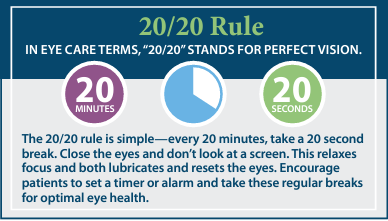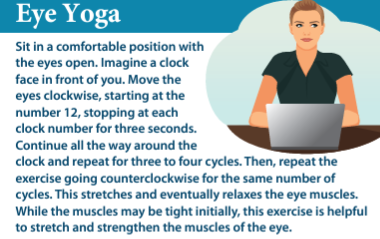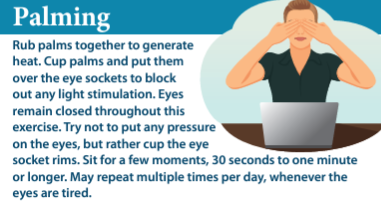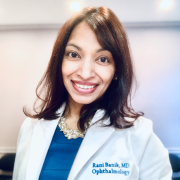Case Study Excerpt: Vision Care Through a Natural Lens

Patient Information
Tom is a 45-year-old technology department manager living with his wife and three children in a suburban midwestern town. He works primarily on his computer and phone for up to 12 hours per day and spends most of his free time in front of the television or checking e-mail on his tablet.
- Race/Ethnicity: White/Caucasian
- Date of Birth: September 18, 1976
- Marital Status: Married
- Problems: Migraine headaches, lattice degeneration
- Allergies: Seasonal
Social History:
- Alcohol: Daily use, 1-2 beers per day, occasional liquor on the weekends
- Smoking: No history
Vital Signs:
- Height: 71 inches (5’11”)
- Weight: 201 pounds
- BMI: 28.0
- Total cholesterol: 195
- HDL cholesterol: 70
- Blood pressure systolic: 142 mm Hg
- Blood pressure diastolic: 87 mm Hg
- Non-fasting glucose: 107
Medications:
- Over-the-counter pain relievers
- Prescription triptans
Health Concerns:
- Blurry/strained vision with occasional floaters
- Dry, itchy eyes
Practitioner Perspective: Rudrani Banik, MD
Rudrani wants to address three main health issues with Tom, including digital eye strain, dry eye, and migraine headaches. Her overall goal is to help Tom adopt lifestyle habits that will improve not only his vision but also his overall health.
First Visit
The first office visit for Tom would consist of a comprehensive integrative consultation lasting up to three hours. Rudrani would personally take a thorough health history, using the conversation to not only gather information but observe the nuances of how Tom responds, which could help formulate his care plan.
The consultation would include taking a very extensive health history for 45 to 60 minutes, as well as several tests in office. Tests would include standard ophthalmic tests as well as some integrative tests, including overall vision, color vision, visual field and peripheral vision, pupils, and ocular motility. Rudrani would look for any issues with ocular misalignment, depth perception, and near and distance vision using both eyes. Additionally, she would conduct a slit lamp exam under the microscope to see how anatomy looks, a dilated exam to see both the optic nerve and retina and an optical coherence tomography (OCT) test, which is a high-resolution light-based ultrasound of the optic nerve and retina to observe the sense of structure and whether the nerve is healthy. She would also take photographs as part of Tom's basic workup.
The intake would also include discussion about Tom's nutrition and lifestyle. Rudrani would ask thoughtful questions about Tom's eating habits to help create a personalized nutrition plan. According to Rudrani, so much of eye health in the long term depends on proper nutrition. Prevention of common eye conditions, including cataracts, glaucoma, and macular degeneration, rests on getting proper nutrients for the eyes, so creating a diet plan that incorporates nutrient-rich foods would be important for Tom.
Care Plan
Rudrani said it seems like Tom has three main issues having to do with vision and overall health. First is digital eye strain, which she said likely comes mainly from spending so much time in front of screens, leading to eye fatigue. Digital eye strain is a syndrome that encompasses various symptoms, including difficulty focusing, blurry vision, dry eye, headaches, light sensitivity, and sometimes neck and shoulder pain, all stemming from time spent on a screen. Rudrani said it does not matter the type of screen—phone, tablet, computer, television—as any screen can trigger digital eye strain. Rudrani’s initial approach with Tom would be to address digital eye strain with specific treatment strategies.
The second issue Rudrani would want to address with Tom would be dry eye. Dry eye symptoms may be secondary to digital eye strain or there may be something else going on leading to his dry eye, Rudrani said. Rudrani would want to look for the root cause of Tom’s dry eye, which would start with additional tests, including certain stains on his cornea to see what the surface looks like, as well as the health of his cornea and conjunctiva. She would also look at the eyelid glands using a non-invasive device with a camera that can image the glands to look for meibomian gland dysfunction (MGD). Glands secrete oils that contribute to the tear film and help prevent tears from evaporating, so if the glands are not healthy or functioning well, the oils aren't healthy, and the tears evaporate, leading to significant dry eye symptoms. Additionally, Rudrani would look at his blink reflex. Understanding the root cause of his symptoms would help Rudrani develop a targeted treatment plan for Tom.
Third, Rudrani would want to address Tom's headaches and migraines. Though Tom does not experience headaches too often, there are still strategies that can be implemented to reduce the headaches themselves as well as reduce morbidity from headaches and help him live a healthier lifestyle free of pain. By focusing on these three complaints with integrative approaches, Rudrani would design a program for Tom.
Customizing Approaches
Tom appears to be under stress from work, which entails a lot of screen time. Rudrani said this must be addressed, so she would provide strategies to help him improve endurance on the screen, comfort level, and dry eye. These approaches would start with a deep dive into nutrition.
Certain nutrient-rich foods are great for eye health, including green leafy and other colorful vegetables. Rudrani would want to help make Tom more aware that what he's eating can have an impact on his eye health for the years and decades to come. All too often, patients take eye health for granted, and it's only when they lose vision or have vision issues that it becomes a focus. To maintain good eyesight for a lifetime, patients need to start early, in childhood and early adulthood, by optimizing diet and lifestyle, Rudrani said.
For Tom and his digital eye strain, Rudrani would educate him about the natural blue light blockers inside the eyes. Pigments— lutein, zeaxanthin, and meso zeaxanthin—in the retinas help absorb and neutralize high energy, short wavelength blue and ultraviolet light, acting as natural blue blockers and sunglasses for the eyes. These pigments come from plants and are considered essential, meaning the body cannot synthesize, so they must be consumed in the diet. Foods richest in these pigments are green leafy vegetables such as spinach, kale, collard greens, Swiss chard, and dandelion greens. Certain yellow and orange foods are also high in pigments, such as egg yolks, the beautiful yellow-orange color of which comes from lutein and zeaxanthin. Rudrani said eating eggs two to three times per week may be beneficial for the eyes, as well as other orange and yellow foods like peppers, corn, and spices like paprika. Rudrani would help Tom start to incorporate these foods with what she calls a plant-rich diet, incorporating at least five cups of colorful fruits and vegetables a day to give the eyes a range of nutrients. The eyes need the whole spectrum of colors and over 20 different vitamins, minerals, antioxidants, compounds, and bioflavonoids to stay healthy, and the best way to get that is through plants.
It’s estimated that the eyes need 6.5 milligrams of lutein per day and 1 to 2 milligrams of zeaxanthin per day, Rudrani said. Most people on a Western diet are only getting 1 to 2 milligrams of lutein per day and less than 1 milligrams of zeaxanthin per day, meaning they are likely deficient. In this situation, to prevent symptoms, it would be important to supplement. Rudrani said patients should look for a supplement that has lutein, zeaxanthin, and meso zeaxanthin. Most have 10 to 20 milligrams of lutein and about 2 to 4 milligrams of zeaxanthin. However, an easy way to get these pigments in the right ratios is to look for the ingredient Lutemax 2020, which is an extract found in many eye health supplements on the market and guarantees the pigments are in the proper ratios that the eyes need. This ingredient would be listed on the Supplement Facts label.
Additionally, Rudrani would want to make sure Tom is getting enough omega-3 fatty acids. This would be especially important for dry eye as well as retinal health and blue light protection. Retinas, which are made of omega-3 fatty acids, have very high metabolic rates and are constantly regenerating. In fact, the highest concentration of omega-3 fatty acids in the body is in the retina. Omega-3 fatty acids are needed for optimal retina health and may be obtained via fresh fish like salmon, trout, sardines, and anchovies or plant-based sources like hemp seeds, flaxseeds, and chia seeds. Supplementation is also acceptable, and there are many omega-3 fatty acid supplements on the market.
For Tom's dry eye or retinal issues, Rudrani would recommend a supplement with 2,000 to 4,000 milligrams of omega-3 fatty acids, docosahexaenoic acid (DHA), and eicosapentaenoic acid (EPA). Additionally, Rudrani would want to ensure a good ratio of omega-3 fatty acids and omega-6 fatty acids and would recommend a supplement that also includes gamma linoleic acid (GLA). Many eye health-specific supplements on the market include DHA, EPA, and GLA.
Another key component in Tom's treatment plan would be his lifestyle. Rudrani said it's estimated that most adults spend more than 10 hours a day, and children spend more than six hours a day on a device. For Tom, Rudrani would encourage taking breaks throughout the day, and building breaks into his schedule using what she calls the 20/20 rule.

There are also a couple of eye exercises patients can do throughout the day, which Rudrani would walk Tom through. While the exercises don’t improve vision per say, they help relieve symptoms of digital eye strain.
This exercise can be relaxing for people who are light-sensitive or who experience headaches or dry eye. Additionally, it can help with floaters. While there is no non-surgical method to get rid of floaters, palming helps the mind decrease awareness and look past the floaters. It is considered a mind and eye exercise, which can refresh the eyes and improve visual endurance.


The most important thing for Tom would be to get his family to buy into the program. If he does it alone, it could be challenging and isolating, especially if he is the only one eating certain foods in the household. Rudrani would encourage Tom to get the entire family engaged by meal planning, grocery shopping, and cooking together or selecting new takeout options that offer more beneficial nutrients. This would not only support Tom but also instill in his children the importance of maintaining good eye health through nutrition early on, as well as developing healthy lifestyle habits.
Rudrani would also want to encourage Tom to work with his family to reduce their collective screen time by implementing rules and strategies across the household. If Tom is myopic, his children are also at high risk of developing myopia. In the United States, 30 percent of people are myopic, and it's estimated that by 2050, this statistic will increase to 50 percent, Rudrani said. There is some research that shows spending two hours a day outdoors decreases the progression of myopia, which is especially important for children. Rudrani would encourage Tom to make family plans where they spend at least two hours outdoors together, whether it involves exercise or simply enjoying time outside.
Long-Term
For Tom, Rudrani would hope to teach him how to protect his vision for a lifestyle and prevent diseases like cataracts, glaucoma, and macular degeneration through diet and lifestyle. Once a treatment plan has been established, Rudrani would want to see Tom after three months for a check-in appointment via telemedicine if there isn't anything on the eye exam that needs to be checked in person. If symptoms improve, Rudrani would want to follow up again with Tom in six months. If symptoms persist, Tom would come in again after three months until improvement. Once stabilized, Tom could come in once per year for an annual exam.
About the Expert

Rudrani Banik, MD, specializes in ophthalmology, neuro-ophthalmology, and headache. She has created a Center of Excellence using her unique approach to vision health and wellness. Banik is internationally known for her expertise in ophthalmic and neuro-ophthalmic care. She manages a wide spectrum of conditions affecting vision, as well as the complex connections between the eye and brain. She combines traditional medical and surgical treatments of the eye with nutritional and lifestyle approaches for a more integrated, holistic approach to vision and brain health. Banik has won many awards including Castle Connolly Top Doctor and New York Magazine Best Doctor. She is frequently featured in the media as an expert in the field.
Editor’s Note: This article is an excerpt from the e-book, Vision Care Through a Natural Lens: An Integrative Medicine Case Study. To read more, click here.




















SHARE